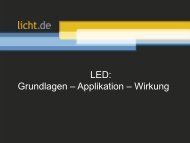licht.wissen No. 01 "Lighting with Artificial Light"
Booklet 1 is intended for all those who want to delve into the topic of light and lighting or wish to familiarize themselves with the basics of lighting technology. It also helps to make a decision in the field of lighting. Free Download at www.licht.de/en
Booklet 1 is intended for all those who want to delve into the topic of light and lighting or wish to familiarize themselves with the basics of lighting technology. It also helps to make a decision in the field of lighting. Free Download at www.licht.de/en
Create successful ePaper yourself
Turn your PDF publications into a flip-book with our unique Google optimized e-Paper software.
<strong>licht</strong>.<strong>wissen</strong> <strong>01</strong><br />
<strong>Lighting</strong> <strong>with</strong> <strong>Artificial</strong> Light<br />
Light generation in the 21 st century<br />
LEDs have revolutionized lighting in recent years. New and efficient technologies are increasingly replacing<br />
the old thermal radiators.<br />
A ++<br />
A +<br />
A<br />
B<br />
C<br />
D<br />
E<br />
Y IJA<br />
IE IA<br />
A ++<br />
XXX kWh/1000h<br />
Manufacturer<br />
or brand<br />
Product code<br />
Lamp energy<br />
efficiency<br />
class<br />
Power<br />
consumption<br />
in kilowatt<br />
hours over<br />
1,000 hours<br />
of use<br />
The relative importance of different types of<br />
light generation has shifted dramatically in<br />
recent years: incandescent light bulbs, even<br />
in the form of halogen lamps, are on the<br />
decline. Fluorescent lamps and other gas<br />
discharge lamps are also increasingly being<br />
replaced by LED technology – in the form<br />
of retrofit lamps, modules or complete systems.<br />
Why the change?<br />
The generation of artificial light requires<br />
energy: 15 percent of electric power worldwide<br />
is still used for lighting (IEA/UNEP,<br />
spring 2<strong>01</strong>4). Which is why any efforts to<br />
reduce energy consumption always involves<br />
lighting savings. The photometric<br />
requirements for each application must<br />
nevertheless be met (such as minimum<br />
illuminance at work), as these are often<br />
safety-related, and thus also of legal significance.<br />
Governments are applying great pressure<br />
in order to save light-related energy; the<br />
European Union (EU) has introduced directives<br />
aimed at increasing energy efficiency.<br />
Light sources that do not meet these requirements<br />
may no longer be marketed as<br />
new products in the EU. In addition, end<br />
users are informed by corresponding markings<br />
on the energy labels showing which<br />
light sources are highly efficient (A++ <strong>with</strong><br />
green arrow = “desirable”) and which are<br />
particularly inefficient (E <strong>with</strong> red arrow =<br />
“Warning, not desirable”). Similar arrangements<br />
now also apply in other countries<br />
outside the EU.<br />
technology must effect a major change if<br />
they wish to remain successful in the<br />
market. However, efficiency is not everything:<br />
besides generating brightness, light<br />
also needs to meet other requirements<br />
(see “Quality characteristics of lighting”,<br />
page 15).<br />
At the same time the applications are becoming<br />
increasingly complex, which is why<br />
there is now strong demand for professionals<br />
in the planning, implementation and<br />
operation of good lighting systems. This is<br />
giving rise to new opportunities because<br />
there is now an increased focus on controllability,<br />
and thus also the question of what<br />
“language” the components use to speak<br />
<strong>with</strong> one another; should DALI components<br />
be integrated into a bus system or is wireless<br />
control preferable?<br />
Colour? Dimming? It is the user who decides<br />
how elaborate the system should be<br />
and how it is ultimately controlled: preprogrammed<br />
and then automatically controlled,<br />
or by APP, by switch or remote<br />
control.<br />
Light generation – traditional:<br />
Incandescent and halogen lamps<br />
Incandescent and halogen lamps are thermal<br />
radiators in which light is generated by<br />
heating the tungsten filament wire. The<br />
glass bulb can be evacuated or filled <strong>with</strong><br />
gas – generally <strong>with</strong> noble gas(es) or nitrogen.<br />
Incandescent lamps have low luminous<br />
efficacy, but they offer perfect colour<br />
rendering and are fully dimmable.<br />
59<br />
© <strong>licht</strong>.de<br />
[59] The energy label for lamps (as of<br />
September 2<strong>01</strong>3) provides information on<br />
the efficiency classes of light sources. LEDs<br />
and energy saving lamps are especially<br />
efficient.<br />
[60] Efficient and elegant. The curved OLED<br />
ceiling lamp provides pleasant, glare-free<br />
light.<br />
What does this change mean<br />
in practice?<br />
Light sources and lamps based on less<br />
energy-efficient technologies are either no<br />
longer produced as a direct result of the<br />
directives or are losing their attraction to<br />
such an extent that they are no longer used<br />
– regardless of any other benefits they may<br />
have. Thus, manufacturers which previously<br />
worked mainly <strong>with</strong> traditional lighting<br />
However, the luminous efficacy can be increased<br />
by means of double coiling and/or<br />
refinement of the gas filling, e.g. through<br />
the addition of krypton or xenon. Halogens<br />
reduce the evaporation of tungsten from<br />
the filament, thereby preventing bulb blackening<br />
in halogen lamps. Further efficiency<br />
gains can be obtained through the use of<br />
infrared (IR) reflective coatings of the glass<br />
bulb.<br />
30

















